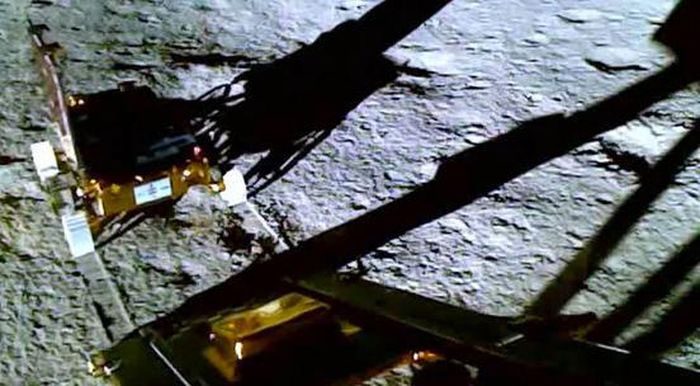The most populous country in the world is aiming to launch a lunar probe to bring samples back to Earth by 2027.
According to the head of India’s space exploration agency on December 14, the RT television channel reported that the country will launch another mission to the Moon within the next four years to bring back samples from the lunar surface to Earth. Sreedhara Panicker Somanath, Chairman of the Indian Space Research Organisation (ISRO), stated that India’s interest in the Moon remains very high.

Screenshot from the video of Chandrayaan-3 landing on the Moon.
In a statement at the Presidential Palace, Somanath declared: “I assure you that we will bring back some Moon rocks ourselves. However, this mission will not be easy.”
Further explaining the plan, Somanath mentioned that more technology will be needed to collect items from the Moon and return them to Earth. ISRO aims to complete the mission within the next four years despite the complexity involved.
The head of ISRO also confirmed that the ambitious Gaganyaan project, which aims to send Indian astronauts into space, is being actively developed. Service and crew modules are currently being designed and trained.
The space agency conducted its first test flight last October to prepare for the manned mission. The main module flipped over after falling into the sea. Next year, ISRO plans to conduct another test to ensure the module remains upright after a fall.
Meanwhile, the crew for the mission has been training at the Yuri Gagarin Cosmonaut Training Center in Russia and is receiving additional training in India.
In October, Indian Prime Minister Narendra Modi chaired a high-level meeting, emphasizing that ISRO should strive to build a space station by 2035 and send the first Indian to the Moon by 2040.
Somanath indicated that before the Indian space station is constructed, a robotic module will be launched, clarifying that the manned space station will only appear in 2035. He also noted the necessity of building a dynamic industrial base for domestic space activities.
On December 15, India’s Minister of Petroleum and Natural Gas, Hardeep Singh Puri, told ANI that the space sector will receive support to achieve the ambitious goals set by the country’s leadership.
In August, India’s Chandrayaan-3 successfully completed its mission to the Moon. This spacecraft was built at a cost of only $75 million, utilizing domestically designed components. Last month, a part of the spacecraft re-entered Earth’s atmosphere and fell into the Pacific Ocean.
For the next lunar exploration, ISRO is considering collaboration with the Japan Aerospace Exploration Agency. The joint Lunar Polar Exploration mission (Lupex) aims to explore the Moon’s South Pole and assess the amount of extractable water from its surface.
The year 2023 marked significant achievements for the Indian space agency. In addition to the successes with the Chandrayaan-3 probe, India launched its first solar probe, Aditya-L1, in September. The video of Chandrayaan-3 landing on the Moon garnered over 79 million views on YouTube, making it the most-watched Indian video on the platform this year.





















































